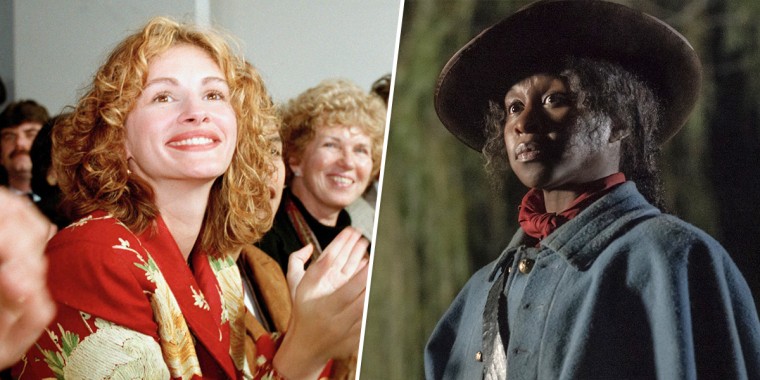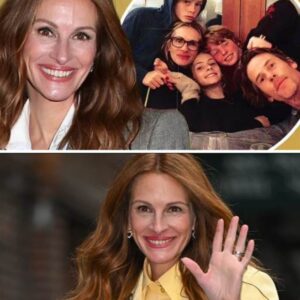The movie industry often hops on the diversity train when it becomes profitable. And then it just as quickly hops back off again.

Julia Roberts in 1994, and Cynthia Erivo as Harriet Tubman in “Harriet.”Chrystyna Czajkowsky, Glen Wilson / AP file, Focus Features
Hollywood hardly has had a stellar track record when it comes to diversity and inclusion, from its dismal (and continuing) use of yellowface, its past (and present) utilization of blackface or the prevalence of brownface in movies as wide-ranging as “West Side Story,” “Argo,” “A Beautiful Mind” and “House of the Spirits.” However, a recent revelation proves just how absurd its insistence on relying on such tropes really is, and how resistant the industry has been to change.
In a recent interview with Focus Features, Gregory Allen Howard, the screenwriter behind2019’s Harriet Tubman biopic “Harriet,” dropped a bombshell.
Howard, who has been working for more than two decades to get Tubman’s story to the big screen, said that, when he first began his journey in 1994, a studio executive suggested that Julia Roberts — then a 27-year-old starring in a summer rom-com with Nick Nolte — should portray the former slave, freedom fighter and abolitionist.
“I was told how one studio head said in a meeting, ‘This script is fantastic. Let’s get Julia Roberts to play Harriet Tubman,'” Howard remembered. “When someone pointed out that Roberts couldn’t be Harriet, the executive responded, ‘It was so long ago. No one is going to know the difference.'”
Though appalling, it’s on-brand for Hollywood, especially given to the cinema landscape of the time. Following the Blaxploitation films and Richard Pryor comedies of the 70s, the 80s were a time when Eddie Murphy was one of the only Black A-listers getting work as a leading man and Spike Lee one of the few prolific black directors.
The cinema landscape for Black film shifted drastically in the 90s, however: In “Mainstream African American Cinema: The Struggle for Black Images in Hollywood,” Wendy Sung wrote, “1991 proved to be a groundbreaking year, with 12 films directed by African Americans and 20-some other productions that starred or had significant roles for black actors.”
But the predominantly Black films that were being funded and praised by Hollywood bigwigs focused on the inner-city with a male gaze: The late John Singleton’s acclaimed “Boyz n the Hood,” the Hughes Brothers’ “Menace II Society” and Mario Van Peebles’ “New Jack City” dominated the conversation.
Films that highlighted Black women and showed historical figures, like Kasi Lemmons’ “Eve’s Bayou” (the director behind 2019’s “Harriet”) or HBO’s “The Josephine Baker Story,” came later in the decade or found a home on network television instead of in cinema houses, even as Black actors such as Denzel Washington and Halle Berry cracked the ranks of A-listers in mostly mainstream films.
By the early 2000s, aside from the near-frantic production levels from Tyler Perry Studios, diverse and inclusive stories in mainstream Hollywood were virtually nonexistent. Despite the massive boom of Black stories in the ’90s that brought in millions of dollars, Hollywood apparently decided that Blackness was no longer profitable.
In “Framing Blackness,” film scholar Ed Guerrero wrote, “[Black films] hit the notorious glass ceiling in a double-sense; that is, black films are limited to roughly a dozen, mostly black-male-directed, productions a year, with the overwhelming majority of them relegated to budgets well below $30 million.”
Even as film studios were discarding Black actors, screenwriters and directors, Broadway and the television industry were embracing color-blind casting. Broadway, for instance, began shifting slowly, casting singer Toni Braxton in Broadway’s ‘Beauty and the Beast” in 1998; later, Shonda Rhimes embraced this type of casting with her hit TV shows, “Grey’s Anatomy,” (which premiered in 2005) “Scandal,” and “How To Get Away With Murder.”
Film studios, in contrast, kept doing the exact opposite — casting white actors in roles meant for people of color. With everything from Scarlett Johansson’s role in “Ghost in the Shell,” Finn Jones as Danny Rand in Netflix’s “Iron Fist” and Emma Stone’s role in “Aloha” — just to start with three of the biggest recent headlines — 25 years after Roberts was suggested for Harriet Tubman, Hollywood still couldn’t be bothered to champion actors of color in roles that were meant for them.
Nonetheless, the success of Broadway’s “Hamilton” and other colorblind castings likely emboldened other shows — like “Harry Potter and the Cursed Child,” and the recent Audra McDonald version of “Frankie and Johnny in the Clair de Lune” — and studios — like Disney with it’s casting of Halle Bailey in the live-action version of “The Little Mermaid” — to use colorblind casting.
And, during his Focus interview, Howard explained that his Harriet Tubman biopic was given the green light only after two predominantly Black-cast films shattered box office expectations. “When ’12 Years a Slave’ became a hit and did a couple hundred million dollars worldwide, I told my agent, ‘You can’t say this kind of story won’t make money now,'” he said. “Then ‘Black Panther’ really blew the doors open.”
In “Framing Blackness” — Guerrero suggests that “the movie industry routinely ignores black filmic aspirations and marginalizes black box office power until it can be called on… to make up sinking profit margins at any given moment of economic crisis.”
It’s evident with streaming services, the low-production of Hollywood films and the astronomical ticket prices at the box office that Hollywood is in a slump. They are doing everything in their power to draw in dollars.
But 25 years after a Hollywood executive called for Julia Roberts to be cast as Harriet Tubman, true diversity and inclusion within the studio system has not yet been achieved. Blackness is currently a commodity, but a flop or two from a predominantly Black-cast or “diverse” film at the box office could certainly change that.
And, this push toward diversity, especially when Black actors are cast, still causes uproar. This notably occurred with the 2012 film adaptation of “The Hunger Games.”
Though her race was never explicitly stated in the book, the character of Rue was described as a darker-hued character. But the casting of Black actor Amandla Stenberg caused a firestorm from bitter white fans of the dystopian franchise.
And when Noma Dumezweni was cast in 2015 as Hermione Granger in “Harry Potter and the Cursed Child” on Broadway, series creator J.K. Rowling and actress Emma Watson who played Hermione in the Potter films both had step forward to lend their support to the actress amid the backlash.
Meanwhile, though it has been heralded as one of the best Broadway productions of a generation in no small part because it reimagines the Founding Fathers as people of color, some white actors were miffed to discover a “‘Hamilton”‘ casting ad in 2016 that called for “nonwhite” performers to audition for leading roles.
Such false shouts of “reverse racism”— something that does not exist — suggest that, as much as Hollywood is resistant to diversity, the general American public has also continues to cling to notions that “white is right” while spreading the fear-mongering tale of the de-whitening of America.
(Luckily, “Hamilton’s” producers stood firm in their casting choices, saying, “It is essential to the storytelling of ‘Hamilton’ that the principal roles, which were written for nonwhite characters (excepting King George), be performed by nonwhite actors.”)
Thus, as Hollywood continues on its diversity and inclusion kick, actors of color will be cast in “mainstream roles,” but continue to be subjected to bullying and harassment by white people who are afraid to see the humanity in actors who don’t look like them.
(The new ‘Star Wars’ franchise actor, Kelly Marie Tran, has spoken of this problem openly and eloquently.) It cannot be left to these actors to face that bullying and harassment alone.
We also must address the white American public’s unwillingness to grapple with the institution of slavery, and it’s present-day ramifications. In 1994, only 130 years after the Emancipation Proclamation, a major Hollywood power player called slavery “so long ago.”
Unless the public and Hollywood deals with its anti-blackness and broader racism — and the repercussions of how that has persisted over centuries — actresses like Scarlett Johansson will continue to feel emboldened to gobble up spaces and roles that were meant for others.
News
‘I consider myself a homemaker’: Julia Roberts details ‘pride’ over decision to step back from spotlight to raise her three children and laments the lack of good romcoms in recent years
Julia Roberts was once the queen of the romantic comedy, though she hasn’t made one in more than 20 years… until her new project Ticket to Paradise. The 54-year-old…
Is Nicolas Cage underneath all that fur? The beard hid a legend and was unrecognizable at the movie premiere.
Laurence Fishburne and Nicolas Cage (Credit: Emma McIntyre/Getty Images) Is that Nicolas Cage underneath all that fur? Apparently it was, as the idiosyncratic screen legend attended to…
Weston Cage, Son of Nicolas Cage, Under Police Investigation for Alleged Attack on Mother
Weston is Nicolas’ oldest child and his only with Christina Fulton From L: Nicolas Cage, Weston Cage and Christina Fulton. PHOTO: JOHN SHEARER/WIREIMAGE; GABRIEL OLSEN/FILMMAGIC; ROBIN L MARSHALL/GETTY Weston…
Nicolas Cage, FKA Twigs & Noah Jupe in ‘The Carpenter’s Son’ – Cannes Hot Project
Nicolas Cage, FKA twigs, Noah Jupe, Souheila YacoubGetty Images, Pip Nicolas Cage, FKA twigs, Noah Jupe and Souheila Yacoub are set to star in Egyptian-American director Lotfy Nathan’s The Carpenter’s Son exploring the…
Nicolas Cage Takes on Unique Role in Horror Film: Jesus’ Childhood Story in Production
Nicolas Cage Horror Movie Involving Jesus’ Childhood Being Produced US actor Nicolas Cage attends the premiere of “Renfield” in New York City on March 28, 2023. (Photo ……
Octavia Spencer and Isabela Moner Join Mark Wahlberg’s ‘Instant Family
Octavia Spencer, Isabela Moner, Tig Notaro, Iliza Shlesinger, and Tom Segura have joined Mark Wahlberg and Rose Byrne in the Paramount comedy “Instant Family.” Wahlberg and Byrne will play…
End of content
No more pages to load











